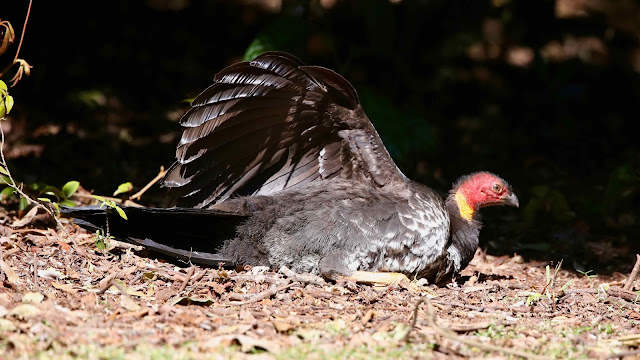Inevitably,
for various reasons, I hit periods with little or no photo subjects and material
for blog posts. Also, inevitably a miscellany of bird photos taken here and
there that do not fit into blog posts accumulate in my photo files. Now is such
a time, so here is an offering of miscellaneous photos captured in July 2018 along
the NSW north coast.
The warm
clear July days on the NSW north coast now seem a distant memory as I sit at
home in East Gippsland Victoria preparing this blog on a cold (it was 10oC
outside at midday), wet and windy Sunday in August – mind you I am not
complaining. After all it is still winter and we are in the grips of a serious
drought so any rain is much appreciated.
Descriptions
of the photos and comments are contained in the photo captions.
Please click on photos
to enlarge.
 |
| Black-fronted Dotterel at the Byron Wetlands. |
 |
| Juvenile Royal Spoonbill – the grubbiest Royal I have ever seen – more like a White Ibis (Bin chicken). Perhaps this bird will improve its personal cleanliness as it matures? |
 |
| An adult Royal Spoonbill – an improvement on the juvenile above but still not as pristine white as the Royals mostly are. |
 |
| Silvereye feeding on a Coast Wattle badly infested with scale insect – there were at least a dozen Silvereyes busy removing scale. |
 |
| Black-backed Magpie Gymnorhina tibicen race tibicen – we have the White-backed Magpie Gymnorhina tibicen race tyrannica here in East Gippsland. |
 |
| Great Egret preening - even in dull light the feather details stand out. |
 |
| Double-barred Finch – a common species in northern Australia and not found East Gippsland. |
 |
| Rainbow Lorikeet - while the gaudy vibrant rainbow colours are not visible in this back view, even the green back is intensely vivid. |
 |
| Australasian Figbird – adult male – Figbirds are rare in Victoria though I note that one found on the Mitchell River in Bairnsdale was reported on Birdline Vic on the 6th of August 2018 – a blue star award for a very rare winter sighting for this mostly summer visitor. |
 |
| Little Wattlebird – probably the most numerous and conspicuous bird in the northern NSW coastal habitats where Coast Banksia was flowering - closely followed by White-cheeked and Brown Honeyeaters and then Noisy Friarbirds. |
 |
| Brown Honeyeater on Banksia serrata flower spike – a small but noisy honeyeater. |
 |
| Noisy Miner – a honeyeater with a sometimes well earned bad reputation. |
 |
| Eastern Osprey on the estuary at Red Rock – they are common along the northern NSW coast and adjoining rivers and estuaries. |
 |
| Same Osprey as above - I couldn't resist including two photos of this magnificent bird. |
Blue-faced Honeyeater – a juvenile with a green face foraging for insects and spiders under Coast Banksia bark.
 |
| Bar-tailed Godwits on the estuary a Sawtell – note the bird on the right is missing a foot and part of its leg – it is surprising how many water birds I see missing legs and feet! |
 |
| The Australian Brush-turkey – a megapode – is very common on the eastern slopes of the Dividing Range and in coastal habitats along the NSW coast north of Sydney. This species seems to be doing especially well in areas close to human development including urban areas. |
 |
| This bird has lifted a wing to expose feathers to the sun. |
 |
|
Pied Oystercatchers in flight off the Red Rock headland.
|
With spring
only a bit over a week away, perhaps my bird photography opportunities will
increase as the weather warms up and the days lengthen?



















No comments:
Post a Comment